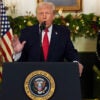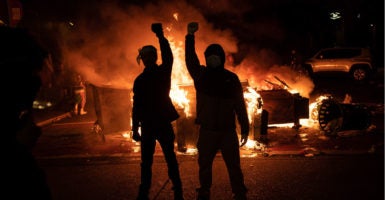There are revolutions and there are revolutions.
There was the French Revolution that swept away the culture and the politics of the old regime in the name of liberte and was cut short by the guillotine.
There was the American Revolution that created a new political order that declared “We the People” shall govern, and guaranteed that they would under the U.S. Constitution.
There was the Bolshevik Revolution that ushered in Marxism-Leninism and resulted in the deaths of more than 100 million victims.
We are in the midst of a revolution right now that affects every institution, political, economic, and cultural, from the U.S. Capitol to Wall Street to Hollywood. Which revolution will be our guide as we answer the challenge of “systemic racism” and protect that most vital ingredient of our republic—ordered liberty?
Will we seek to solve the crisis by reason and debate or by passion and demonstration? Setting aside the Bolshevik model as totalitarian, we must choose between the French and American Revolutions.
Symbols are all important in a revolution—never more than today in the age of social media. Which symbols will dominate this revolution—the guillotine or the Constitution?
What will be our motto—Black Lives Matter or e pluribus unum?
Where will we settle our differences—in the halls of Congress or in the streets of Seattle, Minneapolis, and a hundred other cities?
What will be our legacy—freedom or tyranny?
In a crisis like ours, symbols can inspire and unite. They can also anger and divide. What symbols have commanded our attention these last weeks?
A white cop fatally chokes a black man with his knee. An historic church across from the White House is set on fire—and vandalized a week later. The Lincoln Memorial and the World War II Memorial are both spray-painted. An autonomous people’s zone is established in Seattle and attempted in downtown Washington, D.C.
King Chaos reigns throughout much of the land, and modern Jacobins silence anyone who questions them.
At the Massachusetts Institute of Technology, a chaplain is forced out over his email that condemns George Floyd’s death but notes his criminal record. At the University of California, Los Angeles, a professor reads Martin Luther King’s inspiring “Letter from a Birmingham Jail” in class and is condemned because it contains the “n” word.
Cultural icons are routinely defamed and destroyed. A statue of Junipero Serra, an 18th century missionary and Catholic saint, is pulled down. The movie classic “Gone With the Wind” is removed by HBO from its library. Can Huckleberry Finn be far behind?
Is all this just random violence or is there a pattern? Is the goal of the demonstrators an end to racism in America or an end of academic freedom and political pluralism in America? Are the targets of the mob—a church, a revered president, a just war, a human rights champion—haphazard or deliberately chosen, calculated to undermine public confidence in the pillars of our society?
Surely, you say, that can’t happen here in this land of laws and the Declaration of Independence and the Constitution, in this citadel of democracy. Or can it?
The insightful Chris Bedford of The Federalist, who likes to ask difficult questions, writes that if reason and not chance is behind this Jacobin moment then “targeted killings” of the Jacobins’ opponents and critics may be next.
I hope and pray and believe that will not come to pass. To ensure there will be no modern-day Reign of Terror, all of us must take measured steps to protect our most precious possession—ordered liberty.
We can do that by:
- Freely acknowledging there is real racism in America, not systemic but all too systematic.
- Supporting a national conference on racism attended by blacks and whites of all economic and social backgrounds.
- A series of nationally televised Great Debates between black and white leaders on racism in America.
- National legislation prohibiting the use of excessive police force, warrantless house searches, the automatic use of tear gas in public demonstrations, the deliberate defacing of public monuments and memorials in the nation’s capital and elsewhere.
Most important of all, there must be a commitment to the American Revolution and not the French Revolution as a guide, to George Washington not Robespierre as a model, and to the American flag as the symbol of our united nation.
































